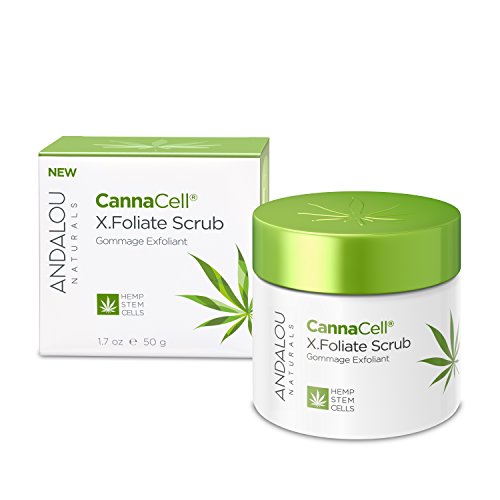
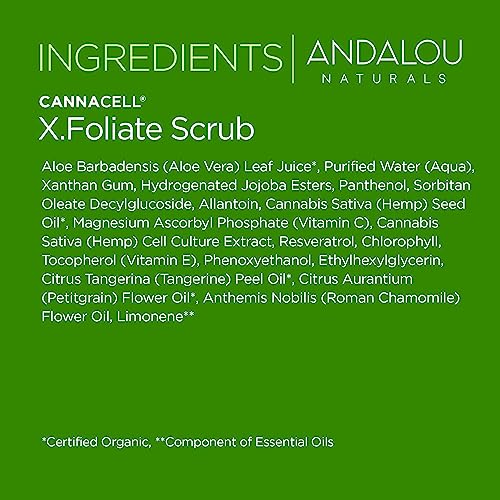

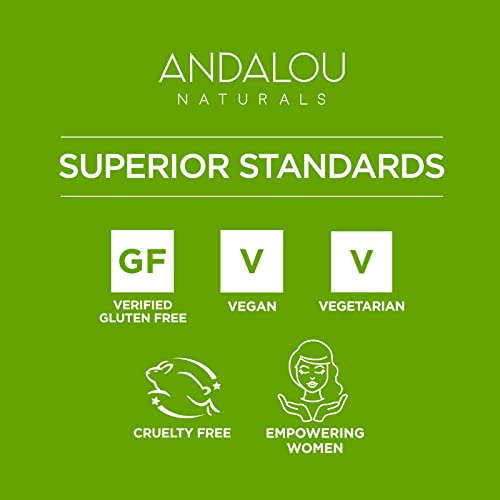
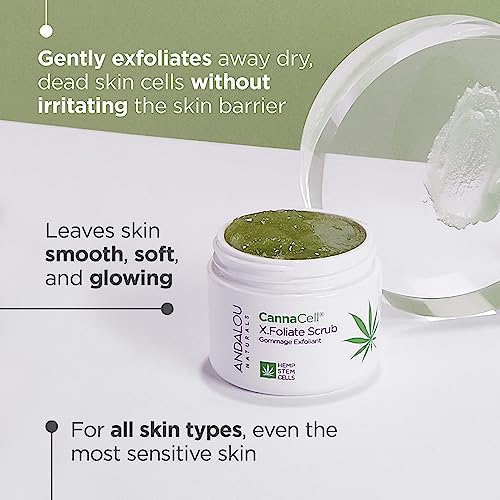
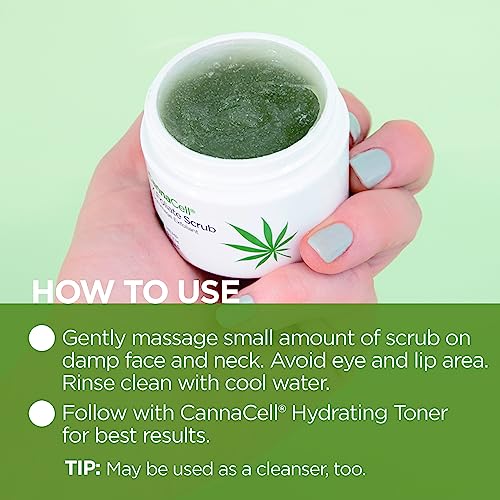
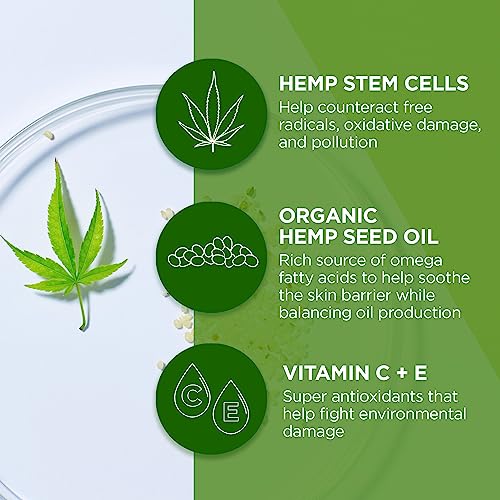
Andalou Naturals CannaCell Body Scrub - Revitalizing Vegan Exfoliant with Antioxidants - 1.7oz


Cannabis Sativa (Hemp) Extract
High RiskCannabis sativa (hemp) extract is derived from the hemp plant, primarily used for its potential therapeutic properties. It contains various cannabinoids, flavonoids, and terpenes, which may contribute to its functional benefits in cosmetic and wellness products. The extract is often sought for its calming and anti-inflammatory effects.
Sustai Insights
Cannabis sativa (hemp) extract offers functional benefits such as anti-inflammatory properties and potential skin-soothing effects. It is derived from sustainably sourced hemp, contributing to its appeal. However, there are health risks associated with its use, including low concerns for carcinogenicity and neurotoxicity. Regulatory restrictions exist in certain jurisdictions, marking it as high risk overall. Safe usage should be practiced, particularly in sensitive applications, and alternatives like hemp seed oil may be considered for specific uses.
Cannabis Sativa (Hemp) Seed Oil
Medium RiskCannabis sativa (hemp) seed oil is extracted from the seeds of the hemp plant. It is rich in essential fatty acids and is commonly used in cosmetic and health products for its moisturizing properties and potential nutritional benefits.
Sustai Insights
Hemp seed oil offers functional benefits such as being a moisturizing agent and providing essential fatty acids. It is typically sustainably sourced and biodegradable. Health risks are low, with minimal concerns regarding carcinogenicity, allergies, and reproductive toxicity. Regulatory warnings exist due to moderate use restrictions. Environmental risks are also low, indicating it does not significantly contribute to pollution or bioaccumulation. Overall, the ingredient is assessed as medium risk, and safe usage practices should be followed. Alternatives include other plant-based oils that offer similar benefits.
Citrus Aurantium Amara (Bitter Orange) Flower Oil
Medium RiskCitrus aurantium amara (bitter orange) flower oil is an essential oil derived from the blossoms of the bitter orange tree. It is commonly used for its fragrance in cosmetic products and is known for its potential use in aromatherapy and skin care formulations.
Sustai Insights
Bitter orange flower oil offers functional benefits as a natural fragrance and may possess antioxidant properties. However, it carries a high allergenic potential, posing risks of skin irritation and allergic reactions in sensitive individuals. Its use is subject to moderate restrictions in various regions, and while it is not classified as a carcinogen, its environmental persistence raises concerns. Overall, the ingredient presents a medium risk profile, necessitating careful usage and consideration of alternatives for sensitive populations.
Citrus Reticulata Peel Oil
Medium RiskCitrus reticulata peel oil is an essential oil derived from the peel of the mandarin orange. It is commonly used in cosmetic and personal care products for its fragrance and potential skin-conditioning properties. The oil is obtained through cold pressing, preserving its natural components.
Sustai Insights
Citrus reticulata peel oil offers functional benefits such as natural fragrance and potential antimicrobial effects. However, it carries a high allergenic potential, with risks of skin irritation and other allergic reactions. Regulatory bodies have noted moderate usage restrictions due to persistence and bioaccumulation concerns. Overall, the ingredient presents a medium risk level, necessitating careful usage practices, particularly for sensitive populations. Safer alternatives may include synthetic or other plant-derived fragrances.
Limonene
Medium RiskLimonene is a scent ingredient and solvent naturally found in citrus fruits, commonly used in personal care and cleaning products for its fragrant properties. It serves as a flavoring agent and enhances the overall sensory experience of products.
Sustai Insights
Limonene offers functional benefits such as acting as a solvent and fragrance enhancer. However, it carries a high allergenic potential, which can trigger skin or respiratory sensitivities in some individuals. Environmental concerns include moderate persistence and bioaccumulation, along with potential ecotoxicity. Regulatory restrictions necessitate verification in products containing this ingredient. Overall, the risk level is assessed as medium, emphasizing the importance of cautious use, particularly for sensitive populations. Safer alternatives may be considered to mitigate these risks.
Phenoxyethanol
Medium RiskPhenoxyethanol is a preservative used in cosmetics and personal care products to prevent microbial growth and extend shelf life. It is commonly found in formulations such as lotions, creams, and serums.
Sustai Insights
Phenoxyethanol serves effectively as a preservative, ensuring product stability and safety by inhibiting microbial growth. It is considered to have low health risks regarding carcinogenicity, allergies, and reproductive toxicity. However, moderate use restrictions exist, and regulatory bodies have advised caution in specific applications. Environmental concerns include its potential as a pollutant, although it is not highly bioaccumulative. Overall, the ingredient presents a medium risk level, with safe usage practices recommended and alternative preservatives available for those seeking greener options.
Anthemis Nobilis (Chamomile) Flower Oil
Low RiskAnthemis nobilis, commonly known as chamomile flower oil, is extracted from the flowers of the chamomile plant. This essential oil is often used in cosmetic and personal care products for its soothing properties and fragrance.
Sustai Insights
Anthemis nobilis offers functional benefits such as skin soothing and anti-inflammatory properties, making it popular in skincare formulations. It is typically sustainably sourced and biodegradable. Health risks are generally low, with no significant concerns regarding carcinogenicity, allergies, or reproductive toxicity. Environmental risks are minimal, and regulatory status is favorable with few restrictions. The overall risk level is low, and safe usage practices include testing for sensitivity. Alternatives like calendula oil may provide similar benefits with a comparable safety profile.
Sorbitan Oleate Decylglucoside Crosspolymer
Low RiskSorbitan oleate decylglucoside crosspolymer is a synthetic polymer derived from sorbitan oleate and decylglucoside. It functions primarily as an emulsifier and thickening agent in cosmetic and personal care products, aiding in the stabilization of formulations and improving texture.
Sustai Insights
Sorbitan oleate decylglucoside crosspolymer offers functional benefits as an effective emulsifier and stabilizer, enhancing product consistency. It has low health risk concerns related to carcinogenicity, allergenic potential, and reproductive toxicity. Environmentally, it presents low bioaccumulation and pollution risks. Regulatory bodies do not impose restrictions on its use. Overall, its risk level is assessed as low, making it a suitable ingredient in formulations.
Chlorophyll
Low RiskChlorophyll is a green pigment found in plants, responsible for the absorption of light energy during photosynthesis. It is commonly used in various products for its coloring properties and potential health benefits. Chlorophyll is often included in dietary supplements and personal care items.
Sustai Insights
Chlorophyll offers functional benefits such as natural coloring and potential antioxidant properties. It is generally recognized as safe with low concerns for cancer, allergies, and reproductive toxicity. Environmental risks are minimal, with no known bioaccumulation or significant pollution. Regulatory bodies, including the FDA, have not placed restrictions on its use. Overall, chlorophyll is assessed as low risk, making it a viable ingredient in products, though it is advisable to follow safe usage practices.
Resveratrol
Low RiskResveratrol is a natural polyphenolic compound found in various plants, notably in the skin of grapes. It is commonly used in cosmetic formulations for its antioxidant properties and potential to enhance skin health. Its primary function in products includes acting as a stabilizer and providing skin protection.
Sustai Insights
Resveratrol offers functional benefits as a powerful antioxidant, potentially enhancing skin health and providing environmental protection. It poses low health risks, with minimal concerns regarding carcinogenicity, allergies, and reproductive toxicity. Environmental risks appear low, with no evidence of bioaccumulation. Regulatory bodies do not currently restrict its use. Overall, it presents a low-risk profile, making it a suitable ingredient with no significant safety concerns.
Magnesium Ascorbyl Phosphate
Low RiskMagnesium ascorbyl phosphate is a vitamin C derivative used in cosmetics primarily for its antioxidant properties and skin-brightening effects. It is often included in formulations for its ability to stabilize vitamin C, enhancing its efficacy in skin care products.
Sustai Insights
Magnesium ascorbyl phosphate offers functional benefits as an effective antioxidant and skin-brightening agent, contributing to improved skin appearance. It has a low risk profile concerning health, with minimal concerns regarding carcinogenicity, allergies, and reproductive toxicity. Environmental risks are also low, with no significant pollutant or bioaccumulation potential noted. Regulatory assessments indicate no major restrictions, supporting its safe use in cosmetic products. Overall, the ingredient is assessed as low risk, with safe usage practices recommended for optimal effectiveness.
Hydrolyzed Jojoba Esters
Low RiskHydrolyzed jojoba esters is a hydrolysate derived from jojoba oil, primarily used in cosmetic formulations for its emollient and conditioning properties. It helps improve skin texture and enhance the spreadability of products, making it a valuable ingredient in creams, lotions, and hair care items.
Sustai Insights
Hydrolyzed jojoba esters serve as effective emollients and conditioning agents, promoting smooth application and improved skin feel. It is considered low-risk regarding health concerns such as carcinogenicity, allergies, or reproductive toxicity. Environmentally, it poses minimal risks with no noted bioaccumulation or significant pollutant potential. Regulatory bodies have not imposed major restrictions. Overall, the ingredient is deemed low risk, with no significant adverse effects reported. Safe usage practices are advised, and alternatives include other plant-derived esters for similar benefits.
Allantoin
Low RiskAllantoin is a naturally occurring nitrogenous compound found in various plants and animals. It is commonly used in cosmetic formulations for its soothing and moisturizing properties, as well as its ability to promote skin cell turnover and healing.
Sustai Insights
Allantoin offers functional benefits such as skin soothing, hydration, and promoting cell regeneration. It is generally recognized as safe, with low concerns regarding carcinogenicity, allergies, and reproductive toxicity. Environmentally, it poses minimal risks, being biodegradable and sustainably sourced. Regulatory bodies do not impose significant restrictions on its use. Overall, the risk level associated with allantoin is low, making it a favorable ingredient in personal care products.
Water
Low RiskWater is a clear, colorless liquid essential for various biological processes. It serves as a solvent in formulations, facilitating the dissolution of other ingredients and enhancing product texture and application. Additionally, water plays a crucial role in hydration and is a key component in many cosmetic and personal care products.
Sustai Insights
Water is an effective solvent and hydrator, contributing to the texture and efficacy of formulations. It is biodegradable and generally regarded as safe, with low concerns regarding carcinogenicity, allergies, and reproductive toxicity. However, excessive water usage can lead to environmental concerns, particularly regarding resource depletion. Regulatory bodies do not impose restrictions on water use in cosmetics. Overall, the risks associated with water are low, making it a safe and essential ingredient.
Panthenol
Low RiskPanthenol, a derivative of vitamin B5, is commonly used in cosmetic formulations for its moisturizing and skin-conditioning properties. It acts as a humectant, helping to retain moisture in the skin and hair, thereby improving hydration and texture.
Sustai Insights
Panthenol offers functional benefits such as effective hydration and skin conditioning, making it valuable in various cosmetic products. It is considered low risk regarding health impacts, with minimal concerns about carcinogenicity, allergies, or reproductive toxicity. Environmental risks are also low, with no significant pollutant or bioaccumulation potential. Regulatory bodies have not imposed restrictions on its use. Safe usage practices include adhering to recommended concentrations. Alternatives like glycerin may provide similar moisturizing benefits, but overall, panthenol is assessed as a low-risk ingredient.
Tocopherol
Low RiskTocopherols are a class of naturally occurring compounds, primarily known for their role as antioxidants. They are commonly used in cosmetic and skincare products to help stabilize formulations and protect ingredients from oxidative damage.
Sustai Insights
Tocopherols provide functional benefits such as antioxidant protection and skin conditioning. They are generally recognized as safe, with low concerns regarding carcinogenicity, allergies, and reproductive toxicity. However, enhanced skin absorption and potential endocrine disruption are noted. Regulatory bodies have not imposed significant restrictions on tocopherols, categorizing the overall risk as low. Safe usage practices should be observed, and while alternatives exist, tocopherols remain a viable option in formulations.
Xanthan Gum
Low RiskXanthan gum is a polysaccharide, a sugar-based compound produced by the fermentation of glucose or sucrose. It is commonly used as a thickening agent and stabilizer in various food and cosmetic products due to its ability to improve texture and prevent ingredient separation.
Sustai Insights
Xanthan gum serves effectively as a thickener and stabilizer, enhancing product texture and consistency. It is biodegradable and typically derived from renewable sources, supporting sustainability efforts. Health risks are minimal, with low concerns regarding carcinogenicity, allergies, and reproductive toxicity. Environmental impact is similarly low, posing no significant hazards. Regulatory agencies, including the FDA, regard it as safe for use, with no significant restrictions. Overall, xanthan gum is assessed as low risk, making it a suitable ingredient in formulations.
Ethylhexylglycerin
Low RiskEthylhexylglycerin is a glyceryl ether utilized primarily as a skin-conditioning agent and preservative in cosmetic formulations. It enhances the efficacy of preservatives and serves as a humectant, helping to retain moisture in the skin. This ingredient is commonly found in various personal care products.
Sustai Insights
Ethylhexylglycerin offers functional benefits as an effective preservative and skin-conditioning agent, contributing to product longevity and moisture retention. Health risks are generally low, with minor concerns regarding allergic contact dermatitis and irritant potential. Environmentally, it poses minimal risks, not being recognized as a pollutant or bioaccumulative. Regulatory bodies have imposed few restrictions, indicating its safety for use. Overall, its risk level is assessed as low, making it a viable option in cosmetic formulations. For those seeking alternatives, ingredients like propanediol may serve similar functions with potentially lower irritation profiles.
Aloe Barbadensis (Aloe Vera) Leaf Juice
Low RiskAloe barbadensis (aloe vera) leaf juice is derived from the succulent aloe vera plant, known for its hydrating and soothing properties. It is commonly used in cosmetic formulations for its moisturizing effects and is often included in products aimed at skin care and healing.
Sustai Insights
Aloe vera leaf juice offers functional benefits as a moisturizer and skin soothing agent, while being sustainably sourced and biodegradable. Health risks are low, with minimal concerns regarding carcinogenicity, allergies, and reproductive toxicity. Environmental impact is also low, with no significant pollutants identified. Regulatory agencies impose few restrictions. Overall, the ingredient poses a low risk, making it a favorable choice in cosmetic formulations.
Anthemis Nobilis (Chamomile) Flower Oil
Low RiskAnthemis nobilis, commonly known as chamomile flower oil, is extracted from the flowers of the chamomile plant. This essential oil is often used in cosmetic and personal care products for its soothing properties and fragrance.
Sustai Insights
Anthemis nobilis offers functional benefits such as skin soothing and anti-inflammatory properties, making it popular in skincare formulations. It is typically sustainably sourced and biodegradable. Health risks are generally low, with no significant concerns regarding carcinogenicity, allergies, or reproductive toxicity. Environmental risks are minimal, and regulatory status is favorable with few restrictions. The overall risk level is low, and safe usage practices include testing for sensitivity. Alternatives like calendula oil may provide similar benefits with a comparable safety profile.
Sorbitan Oleate Decylglucoside Crosspolymer
Low RiskSorbitan oleate decylglucoside crosspolymer is a synthetic polymer derived from sorbitan oleate and decylglucoside. It functions primarily as an emulsifier and thickening agent in cosmetic and personal care products, aiding in the stabilization of formulations and improving texture.
Sustai Insights
Sorbitan oleate decylglucoside crosspolymer offers functional benefits as an effective emulsifier and stabilizer, enhancing product consistency. It has low health risk concerns related to carcinogenicity, allergenic potential, and reproductive toxicity. Environmentally, it presents low bioaccumulation and pollution risks. Regulatory bodies do not impose restrictions on its use. Overall, its risk level is assessed as low, making it a suitable ingredient in formulations.
Cannabis Sativa (Hemp) Seed Oil
Medium RiskCannabis sativa (hemp) seed oil is extracted from the seeds of the hemp plant. It is rich in essential fatty acids and is commonly used in cosmetic and health products for its moisturizing properties and potential nutritional benefits.
Sustai Insights
Hemp seed oil offers functional benefits such as being a moisturizing agent and providing essential fatty acids. It is typically sustainably sourced and biodegradable. Health risks are low, with minimal concerns regarding carcinogenicity, allergies, and reproductive toxicity. Regulatory warnings exist due to moderate use restrictions. Environmental risks are also low, indicating it does not significantly contribute to pollution or bioaccumulation. Overall, the ingredient is assessed as medium risk, and safe usage practices should be followed. Alternatives include other plant-based oils that offer similar benefits.
Chlorophyll
Low RiskChlorophyll is a green pigment found in plants, responsible for the absorption of light energy during photosynthesis. It is commonly used in various products for its coloring properties and potential health benefits. Chlorophyll is often included in dietary supplements and personal care items.
Sustai Insights
Chlorophyll offers functional benefits such as natural coloring and potential antioxidant properties. It is generally recognized as safe with low concerns for cancer, allergies, and reproductive toxicity. Environmental risks are minimal, with no known bioaccumulation or significant pollution. Regulatory bodies, including the FDA, have not placed restrictions on its use. Overall, chlorophyll is assessed as low risk, making it a viable ingredient in products, though it is advisable to follow safe usage practices.
Cannabis Sativa (Hemp) Extract
High RiskCannabis sativa (hemp) extract is derived from the hemp plant, primarily used for its potential therapeutic properties. It contains various cannabinoids, flavonoids, and terpenes, which may contribute to its functional benefits in cosmetic and wellness products. The extract is often sought for its calming and anti-inflammatory effects.
Sustai Insights
Cannabis sativa (hemp) extract offers functional benefits such as anti-inflammatory properties and potential skin-soothing effects. It is derived from sustainably sourced hemp, contributing to its appeal. However, there are health risks associated with its use, including low concerns for carcinogenicity and neurotoxicity. Regulatory restrictions exist in certain jurisdictions, marking it as high risk overall. Safe usage should be practiced, particularly in sensitive applications, and alternatives like hemp seed oil may be considered for specific uses.
Resveratrol
Low RiskResveratrol is a natural polyphenolic compound found in various plants, notably in the skin of grapes. It is commonly used in cosmetic formulations for its antioxidant properties and potential to enhance skin health. Its primary function in products includes acting as a stabilizer and providing skin protection.
Sustai Insights
Resveratrol offers functional benefits as a powerful antioxidant, potentially enhancing skin health and providing environmental protection. It poses low health risks, with minimal concerns regarding carcinogenicity, allergies, and reproductive toxicity. Environmental risks appear low, with no evidence of bioaccumulation. Regulatory bodies do not currently restrict its use. Overall, it presents a low-risk profile, making it a suitable ingredient with no significant safety concerns.
Magnesium Ascorbyl Phosphate
Low RiskMagnesium ascorbyl phosphate is a vitamin C derivative used in cosmetics primarily for its antioxidant properties and skin-brightening effects. It is often included in formulations for its ability to stabilize vitamin C, enhancing its efficacy in skin care products.
Sustai Insights
Magnesium ascorbyl phosphate offers functional benefits as an effective antioxidant and skin-brightening agent, contributing to improved skin appearance. It has a low risk profile concerning health, with minimal concerns regarding carcinogenicity, allergies, and reproductive toxicity. Environmental risks are also low, with no significant pollutant or bioaccumulation potential noted. Regulatory assessments indicate no major restrictions, supporting its safe use in cosmetic products. Overall, the ingredient is assessed as low risk, with safe usage practices recommended for optimal effectiveness.
Citrus Aurantium Amara (Bitter Orange) Flower Oil
Medium RiskCitrus aurantium amara (bitter orange) flower oil is an essential oil derived from the blossoms of the bitter orange tree. It is commonly used for its fragrance in cosmetic products and is known for its potential use in aromatherapy and skin care formulations.
Sustai Insights
Bitter orange flower oil offers functional benefits as a natural fragrance and may possess antioxidant properties. However, it carries a high allergenic potential, posing risks of skin irritation and allergic reactions in sensitive individuals. Its use is subject to moderate restrictions in various regions, and while it is not classified as a carcinogen, its environmental persistence raises concerns. Overall, the ingredient presents a medium risk profile, necessitating careful usage and consideration of alternatives for sensitive populations.
Citrus Reticulata Peel Oil
Medium RiskCitrus reticulata peel oil is an essential oil derived from the peel of the mandarin orange. It is commonly used in cosmetic and personal care products for its fragrance and potential skin-conditioning properties. The oil is obtained through cold pressing, preserving its natural components.
Sustai Insights
Citrus reticulata peel oil offers functional benefits such as natural fragrance and potential antimicrobial effects. However, it carries a high allergenic potential, with risks of skin irritation and other allergic reactions. Regulatory bodies have noted moderate usage restrictions due to persistence and bioaccumulation concerns. Overall, the ingredient presents a medium risk level, necessitating careful usage practices, particularly for sensitive populations. Safer alternatives may include synthetic or other plant-derived fragrances.
Hydrolyzed Jojoba Esters
Low RiskHydrolyzed jojoba esters is a hydrolysate derived from jojoba oil, primarily used in cosmetic formulations for its emollient and conditioning properties. It helps improve skin texture and enhance the spreadability of products, making it a valuable ingredient in creams, lotions, and hair care items.
Sustai Insights
Hydrolyzed jojoba esters serve as effective emollients and conditioning agents, promoting smooth application and improved skin feel. It is considered low-risk regarding health concerns such as carcinogenicity, allergies, or reproductive toxicity. Environmentally, it poses minimal risks with no noted bioaccumulation or significant pollutant potential. Regulatory bodies have not imposed major restrictions. Overall, the ingredient is deemed low risk, with no significant adverse effects reported. Safe usage practices are advised, and alternatives include other plant-derived esters for similar benefits.
Allantoin
Low RiskAllantoin is a naturally occurring nitrogenous compound found in various plants and animals. It is commonly used in cosmetic formulations for its soothing and moisturizing properties, as well as its ability to promote skin cell turnover and healing.
Sustai Insights
Allantoin offers functional benefits such as skin soothing, hydration, and promoting cell regeneration. It is generally recognized as safe, with low concerns regarding carcinogenicity, allergies, and reproductive toxicity. Environmentally, it poses minimal risks, being biodegradable and sustainably sourced. Regulatory bodies do not impose significant restrictions on its use. Overall, the risk level associated with allantoin is low, making it a favorable ingredient in personal care products.
Water
Low RiskWater is a clear, colorless liquid essential for various biological processes. It serves as a solvent in formulations, facilitating the dissolution of other ingredients and enhancing product texture and application. Additionally, water plays a crucial role in hydration and is a key component in many cosmetic and personal care products.
Sustai Insights
Water is an effective solvent and hydrator, contributing to the texture and efficacy of formulations. It is biodegradable and generally regarded as safe, with low concerns regarding carcinogenicity, allergies, and reproductive toxicity. However, excessive water usage can lead to environmental concerns, particularly regarding resource depletion. Regulatory bodies do not impose restrictions on water use in cosmetics. Overall, the risks associated with water are low, making it a safe and essential ingredient.
Limonene
Medium RiskLimonene is a scent ingredient and solvent naturally found in citrus fruits, commonly used in personal care and cleaning products for its fragrant properties. It serves as a flavoring agent and enhances the overall sensory experience of products.
Sustai Insights
Limonene offers functional benefits such as acting as a solvent and fragrance enhancer. However, it carries a high allergenic potential, which can trigger skin or respiratory sensitivities in some individuals. Environmental concerns include moderate persistence and bioaccumulation, along with potential ecotoxicity. Regulatory restrictions necessitate verification in products containing this ingredient. Overall, the risk level is assessed as medium, emphasizing the importance of cautious use, particularly for sensitive populations. Safer alternatives may be considered to mitigate these risks.
Panthenol
Low RiskPanthenol, a derivative of vitamin B5, is commonly used in cosmetic formulations for its moisturizing and skin-conditioning properties. It acts as a humectant, helping to retain moisture in the skin and hair, thereby improving hydration and texture.
Sustai Insights
Panthenol offers functional benefits such as effective hydration and skin conditioning, making it valuable in various cosmetic products. It is considered low risk regarding health impacts, with minimal concerns about carcinogenicity, allergies, or reproductive toxicity. Environmental risks are also low, with no significant pollutant or bioaccumulation potential. Regulatory bodies have not imposed restrictions on its use. Safe usage practices include adhering to recommended concentrations. Alternatives like glycerin may provide similar moisturizing benefits, but overall, panthenol is assessed as a low-risk ingredient.
Tocopherol
Low RiskTocopherols are a class of naturally occurring compounds, primarily known for their role as antioxidants. They are commonly used in cosmetic and skincare products to help stabilize formulations and protect ingredients from oxidative damage.
Sustai Insights
Tocopherols provide functional benefits such as antioxidant protection and skin conditioning. They are generally recognized as safe, with low concerns regarding carcinogenicity, allergies, and reproductive toxicity. However, enhanced skin absorption and potential endocrine disruption are noted. Regulatory bodies have not imposed significant restrictions on tocopherols, categorizing the overall risk as low. Safe usage practices should be observed, and while alternatives exist, tocopherols remain a viable option in formulations.
Xanthan Gum
Low RiskXanthan gum is a polysaccharide, a sugar-based compound produced by the fermentation of glucose or sucrose. It is commonly used as a thickening agent and stabilizer in various food and cosmetic products due to its ability to improve texture and prevent ingredient separation.
Sustai Insights
Xanthan gum serves effectively as a thickener and stabilizer, enhancing product texture and consistency. It is biodegradable and typically derived from renewable sources, supporting sustainability efforts. Health risks are minimal, with low concerns regarding carcinogenicity, allergies, and reproductive toxicity. Environmental impact is similarly low, posing no significant hazards. Regulatory agencies, including the FDA, regard it as safe for use, with no significant restrictions. Overall, xanthan gum is assessed as low risk, making it a suitable ingredient in formulations.
Phenoxyethanol
Medium RiskPhenoxyethanol is a preservative used in cosmetics and personal care products to prevent microbial growth and extend shelf life. It is commonly found in formulations such as lotions, creams, and serums.
Sustai Insights
Phenoxyethanol serves effectively as a preservative, ensuring product stability and safety by inhibiting microbial growth. It is considered to have low health risks regarding carcinogenicity, allergies, and reproductive toxicity. However, moderate use restrictions exist, and regulatory bodies have advised caution in specific applications. Environmental concerns include its potential as a pollutant, although it is not highly bioaccumulative. Overall, the ingredient presents a medium risk level, with safe usage practices recommended and alternative preservatives available for those seeking greener options.
Ethylhexylglycerin
Low RiskEthylhexylglycerin is a glyceryl ether utilized primarily as a skin-conditioning agent and preservative in cosmetic formulations. It enhances the efficacy of preservatives and serves as a humectant, helping to retain moisture in the skin. This ingredient is commonly found in various personal care products.
Sustai Insights
Ethylhexylglycerin offers functional benefits as an effective preservative and skin-conditioning agent, contributing to product longevity and moisture retention. Health risks are generally low, with minor concerns regarding allergic contact dermatitis and irritant potential. Environmentally, it poses minimal risks, not being recognized as a pollutant or bioaccumulative. Regulatory bodies have imposed few restrictions, indicating its safety for use. Overall, its risk level is assessed as low, making it a viable option in cosmetic formulations. For those seeking alternatives, ingredients like propanediol may serve similar functions with potentially lower irritation profiles.
Aloe Barbadensis (Aloe Vera) Leaf Juice
Low RiskAloe barbadensis (aloe vera) leaf juice is derived from the succulent aloe vera plant, known for its hydrating and soothing properties. It is commonly used in cosmetic formulations for its moisturizing effects and is often included in products aimed at skin care and healing.
Sustai Insights
Aloe vera leaf juice offers functional benefits as a moisturizer and skin soothing agent, while being sustainably sourced and biodegradable. Health risks are low, with minimal concerns regarding carcinogenicity, allergies, and reproductive toxicity. Environmental impact is also low, with no significant pollutants identified. Regulatory agencies impose few restrictions. Overall, the ingredient poses a low risk, making it a favorable choice in cosmetic formulations.
Discover the secret to radiant skin with Andalou Naturals CannaCell X.Foliate Scrub. This botanical exfoliating scrub harnesses the power of CannaCell hemp stem cells and organic hemp seed oil to gently invigorate your complexion, revealing your natural beauty.
- Gentle Exfoliation: Formulated with vegan ingredients, this scrub effectively removes dead skin cells, leaving your skin refreshed, smooth, and soft.
- Antioxidant Defense: Packed with antioxidants from hemp stem cells, it helps protect against free radicals and combats premature aging caused by pollution and UV exposure.
- Natural and Pure: With 98% nature-derived ingredients, this cruelty-free and gluten-free scrub aligns with your values for ethical skincare.
- Eco-Conscious Brand: Andalou Naturals emphasizes non-GMO, sustainable sourcing, ensuring transparency and trust in every product.
- Easy to Use: Incorporate this scrub into your skincare routine 2-3 times a week for optimal results; simply apply, massage, rinse, and follow up with your favorite moisturizer.
Empower your skin’s health while supporting sustainable practices with Andalou Naturals CannaCell X.Foliate Scrub.
Subscribe & Save with Sustai
- Best Price Guarantee: Always enjoy the lowest prices on sustainable home essentials.
- No Surprises: We’ll notify you before shipping. No hidden fees, ever.
- You’re in Charge: Change, pause, or cancel your subscription anytime with ease.
- Eco-Friendly Deliveries: Our grouped shipments mean less packaging and lower emissions.
Join us on a sustainable journey. Special offers for a limited time! Prices and promotions may change.
Recommended Products
Discover the secret to radiant skin with Andalou Naturals CannaCell X.Foliate Scrub. This botanical exfoliating scrub harnesses the power of CannaCell hemp stem cells and organic hemp seed oil to gently invigorate your complexion, revealing your natural beauty.
- Gentle Exfoliation: Formulated with vegan ingredients, this scrub effectively removes dead skin cells, leaving your skin refreshed, smooth, and soft.
- Antioxidant Defense: Packed with antioxidants from hemp stem cells, it helps protect against free radicals and combats premature aging caused by pollution and UV exposure.
- Natural and Pure: With 98% nature-derived ingredients, this cruelty-free and gluten-free scrub aligns with your values for ethical skincare.
- Eco-Conscious Brand: Andalou Naturals emphasizes non-GMO, sustainable sourcing, ensuring transparency and trust in every product.
- Easy to Use: Incorporate this scrub into your skincare routine 2-3 times a week for optimal results; simply apply, massage, rinse, and follow up with your favorite moisturizer.
Empower your skin’s health while supporting sustainable practices with Andalou Naturals CannaCell X.Foliate Scrub.

You can have at most 2 Sustainable Steals products in your cart
Customer Reviews
Customers’ View
Customers generally appreciate the gentle and effective nature of the Botanical Exfoliating Scrub. Many users highlight its gel consistency and pleasant citrus scent, noting that it is suitable for sensitive skin without causing irritation. The product has been praised for leaving the skin feeling clean, fresh, and moisturized after use. Several reviewers mentioned visible improvements in skin brightness and softness after just a few applications, reinforcing the scrub's efficacy. Environmentally conscious consumers value the product's formulation, which includes 98% nature-derived ingredients and cruelty-free practices. Overall, customers find this exfoliating scrub to be a reliable choice that aligns well with their health and sustainability values.
AI-generated from the text of customer reviewsThis product has no reviews yet.




